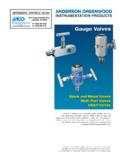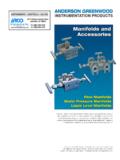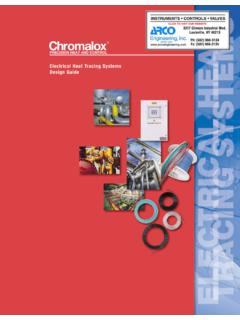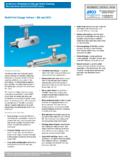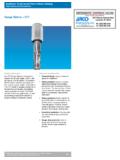Transcription of JET PUMP TECHNICAL DATA pumping gases - …
1 Section 1000 Bulletin 1300 Issued 9/87 Replaces 7/84 JET PUMP TECHNICAL data pumpinggasesThis TECHNICAL bulletin includes general informationabout Penberthy Jet pumps plus specific details forselecting the proper unit. The Penberthy Jet Pumpscovered in this bulletin are used for pumping basic functions of all models included are eitherexhausting, evacuating or jet pumps operateAll jet pumps operate on theprinciple of a fluid entraining asecond fluid. Although design andconstruction may vary, thisapplies to all jet jet pumps have three commonfeatures: inlet, suction, anddischarge. Here is how thesefunction:Inlet The operating medium(liquid, gas, or steam) underpressure enters the inlet andtravels through the nozzle into thesuction chamber.
2 The nozzleconverts the pressure of theoperating medium into a highvelocity stream, which passesfrom the discharge side of the pumping action beginswhen vapor, gases , or liquid in thesuction chamber are entrained bythe high velocity stream emergingfrom the inlet nozzle, lowering thepressure in the suction resulting action causes theliquid, gas, or vapor in the suctionchamber to flow toward - The entrainedmaterial from the suction systemmixes with the operating mediumand acquires part of its energyin the parallel section. In thediffuser section part of the velocityof the mixture is converted to apressure greater than the suctionpressure, but lower than theoperating medium advantages of jets forpumping gasesPenberthy Jet pumps offer manyadvantages over other methods inpumping gases :They have no moving parts,nothing to break or lubrication is are practically noiseless initial cost is cost is low becausethey are compact and nofoundation or wiring is provide reliable operationwith low maintenance pump gas handlingapplicationsThere are numerous possibleapplications for Penberthy JetPumps in handling gases .
3 Jetpumps are commonly found inthese industries:, textile, chemical,food, water treatment, petroleum,research, distilling, gas handling applicationsinclude: gas-air mixers,crystallization, vacuum filters, fluidconcentration, as condensers,fume removal, solvent extractionsystems, drying, vacuumimpregnation, distillation,condensed air removal, de-aerationintroduction and applicationsTYPICAL APPLICATIONSP roducing a vacuumAeration or agitationAir tight container capableof withstanding fullvacuum. Discharge linemust never be smaller thanejector size. (When usingthe LM, a couple ofelbows or a swing checkvalve are necessary toensure that the ejector willsealNozzleParallel SectionInletSuctionDiffuserDischargeSuct ion ChanberSUPPLYVALVEJET PUMP CHECK VALVE OPERATINGPRESSUREAIR OR GASSUPPLYOPERATINGLIQUIDJET PUMPMODEL LMMODEL ELLMODEL FLMODEL GLMODEL GHOperating mediumLiquidLiquidLiquidSteam, airSteam, airOperating medium pressure range20 200 PSIG20 200 PSIG20 100 PSIG60 120 PSIG20 80 PSIGA pplication range, inches - 271 - 2727 306 30 FunctionsEvac / Exh / PrimeEvac / Exh / PrimeExhEvac / Exh / PrimeEvac / Exh / PrimeMODEL UMODEL LMODEL 2 NCOperating mediumSteamSteamSteamOperating medium pressure range80 200 PSIG80 200 PSIG100 200 PSIGA pplication range.)
4 Inches 123 3 FunctionsEvac / ExhEvac / ExhEvac / Exhapplications and selectionTYPICAL APPLICATIONS (cont.)Producing the best possible vacuumPriming centrifugal pumpsPUMPING GASESU sing steam, air or liquid as operatingmediumRefer to the table below for operatingparameters of the jet pumps used forpumping gases . These jets are used topurge gases from chambers, exhaust,evacuate and using the LMterminate discharge pipebelow liquid level or adda couple of elbows or aswing check valve toprovide enough backpressure for ejector to seal .When using the LM, terminatingdischarge pipe under water willprovide enough back pressurefor ejector to sealAt least 40 PSIG below 1 Hg. Absolute may be obtainedHighest point of volumeto be evacuatedVESSEL TO BEEVACUATEDCENTRIFUGALPUMPJET PUMPCHILLED WATERCHECK VALVEJET PUMPOPERATING PRESSURECENTRIFUGAL PUMPSUCTION LIFTThe LM and ELL Jet pumps areused for exhausting, evacuating andpriming operations where a liquidoperating medium is available in a20 to 200 PSIG pressure maximum vacuum with closedsuction is one inch HG ABS.
5 Thesemodels are available with suctionand discharge fittings ranging from1/2 to 12 inches - depending on thetype of (1/2 to 6 ) Fabricated (4 to12 ) Molded (3/4 to 1 ) PVC (1/2 to 3 )The Model FL Fume Movers operate in facilities where the liquidoperating medium is available in the20 to 100 PSIG range. They areidentical in principle to the LM andELL units but differ in their WaterConsumption to Capacity the ELL Model requires morethan 2 GPM of operating fluid foreach SCFM of air pumped, the FLwith 2 GPM can pump approximately14 SCFM of air. The otherdistinguishing factor is the capacity ofthe FL Models to move largevolumes of air at a suction pressurejust slightly below atmospheric. TheELL is more well-suited for movingair at a suction pressure of to 1/10atmospheric pressure about 13times the vacuum of the FLFume Mover.
6 FL Models areavailable with flanged suctionand discharge fittings rangingfrom to 4 and nozzle sizeranging from to 3: dependingon the type of unit AND PRIMING* (Models LM, ELL)First determine: EXAMPLE Volume of Space to be Evacuated ft3 ..30 ft3 Required Evacuation Time minutes ..3 min. Operating Liquid Pressure PSIG (hm) ..80 PSIG Discharge Pressure Required PSIG (hd) ..atmospheric(Refer to LM, ELL Evacuation Time Chart)LM, ELL EVACUATION TIMELM, ELL and FL modelsPUMPING LIQUIDS USING LIQUID OPERATING MEDIUM33100/.min10)3.(100/.)3(Reftfttime EvacuationMinEvacuatetoTimequired=Step 1 Determine evacuation time in minutes per 10 ft3or 100 ft3 depending on volume of space to beevacuated (in this case, 30 ft3 otherwise expressed hundred ft3).
7 *Priming The procedure for selecting Jet pumps forPriming Applications is the same as that for Evacuationexcept:It takes twice the time to prime the same volume that canbe evacuated with a given 2 Locate Operating Water Pressure (in this case 80 PSIG)and Suction Pressure (in this case 5 HG ABS) on the left side of 3 Following along the appropriate line into the 100 ft3 Evacuated section, find the Evacuation Time that s equal to orlower than the Evacuation Time requirement expressed inminutes/100 ft3 (in this case 10 minutes for ELL 2).Step 4 Continuing to the right on the same line, you ll find theOperating Water Used for the selected model (in this case GPMfo rthe ELL 1 .)Then multiply this figure times the ELL 2 Capacity Factor ( ) todetermine the Actual Water Consumption of the selected (GPM OperatingWater Used) ( )= Actual Water ConsumptionLM ELL LM ELL LM ELL LM ELL LM ELL LM ELL LM ELL LM ELL LM ELL LM ELL LM ELL25 15 12 91 12 11 11 7 7 27 27 22 11 13 2 3 Operating Water Pressure (hm)Suction Pressure HG.
8 Abs. (hs)10 CUBIC FEET EVACUATED A B1 Operating Water Used GPM (Qm)100 CUBIC FEET EVACUATEDTIME IN MINUTES PER1 1 1 2 100 PSIG140 PSIG20 PSIG40 PSIG60 PSIG80 PSIGE xhausting (Models LM, ELL, FL)First determine: EXAMPLES uction Load SCFM air (Qs) .. SCFMS uction Pressure Inches Hg. ABS (hs)..15 Operating Liquid Pressure, PSIG (hm)..60 PSIGD ischarge Pressure, PSIG (hd)..5 PSIG(Refer to FL Exhauster and 1 LM and ELL Exhauster Com-parative Performance Chart.)Step 1 Locate appropriate Suction Pressure (in this case 15 ) on leftside of chart and the line that applies to existing WaterPressure (in this case 60 PSIG).Step 2 Read across the 60 PSIG line to the 5 PSIG DischargePressure column noting LM Suction Capacity.
9 SCFM ELL Suction Capacity .. SCFMStep 3 Following along the same line you ll note Operating Water Used .. GPMStep 4 Since the ELL 1 was the unit with the greater suctioncapacity in comparison to our requirement, we ll use it incomputing the Ideal Capacity Factor ( )Desired Capacity ( SCFM)Suction Capacity ELL 1 ( SCFM) (ELL 1 SCFMPer Chart ).613(ELL 1 CapacityFactor ) (GPM OperatingWater Used).613(Selected )= SCFM = GPM = .419 (Ideal )Then using the Capacity Factor Chart, find the size unit thatprovides a capacity factor that s equal to or greater than .419(Ideal )The actual capacity of the selected unit is then determined bymultiplying: Step 5 To determine Water Consumption of the selected unit, multiply:Step 6 In checking the capacity and consumption of the other unitconsidered, we find that the LM 1 , with a capacity of , has a water consumption rate of GPM.
10 It thenbecomes obvious that the ELL 1 is the best unit for thisapplication as it delivers the greatest capacity with the leastvolume of water 7 FL MODELS ONLY The connecting discharge line must besized to handle both the operating liquid and entrained airwithout producing more than a few inches of water dischargepressure. If this cannot be done, a box, tank or separatorshould be provided at the discharge end to separate non-condensable washed gases from the liquid and to ventwashed gases to the "5"30" (Atmo-spheric)25"20"15"20 PSIGOper Water GPM (Qm)SUCTION CAPACITY IN SCFM AT DISCHARGE PRESSURE BELOW (QS)Suction Pressure HG. Abs. (hs)Operating Water Pressure (hm)0 PSIG5 PSIG10 PSIG15 PSIGFL 51 1 1/2"FL 101 1 1/2"BFL 51 1 1/2"FL 101 1 1/2" Water Consumption GPM (Qm)0" (Atmospheric)5"10"Capacity in SCFM At Atmospheric Discharge (Qs)35"Suction Pressure Inches Water Vacuum (hs)Operating Water Pressure (hm)45"15"20"25"30"1 LM & ELL EXHAUSTERS COMPARATIVE PERFORMANCEFL FUME MOVER COMPARATIVE PERFORMANCELM, ELL CAPACITY FACTORSIZE A B 1 1 1 2 2 3 4 6 8 10 12 FACTOR.

